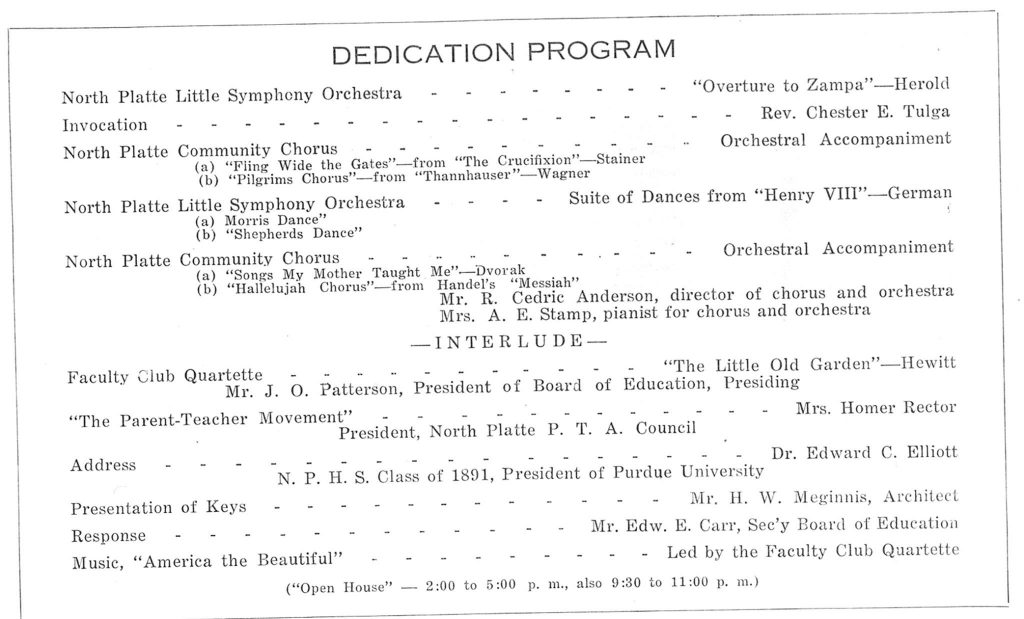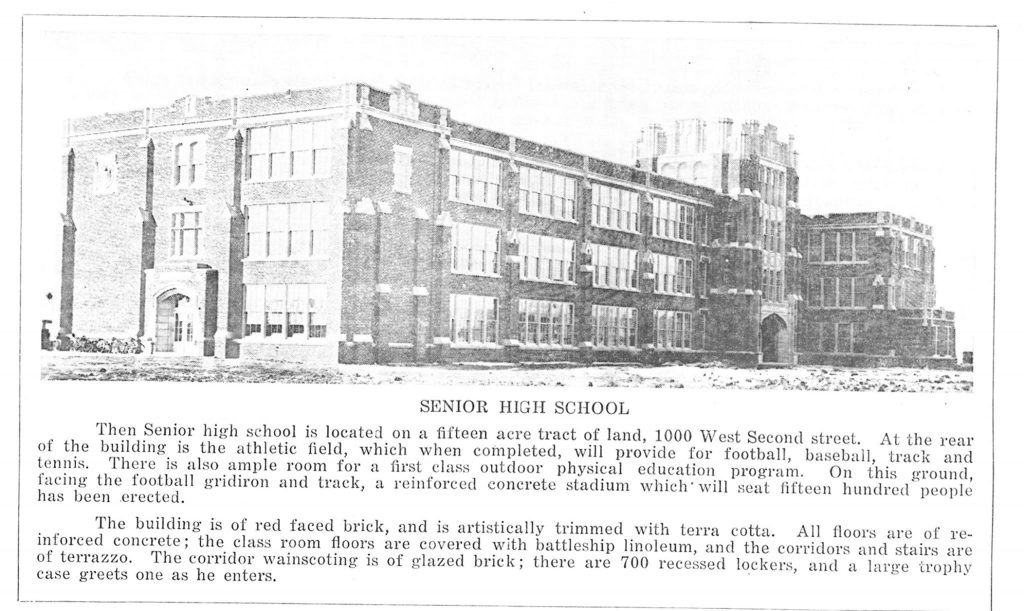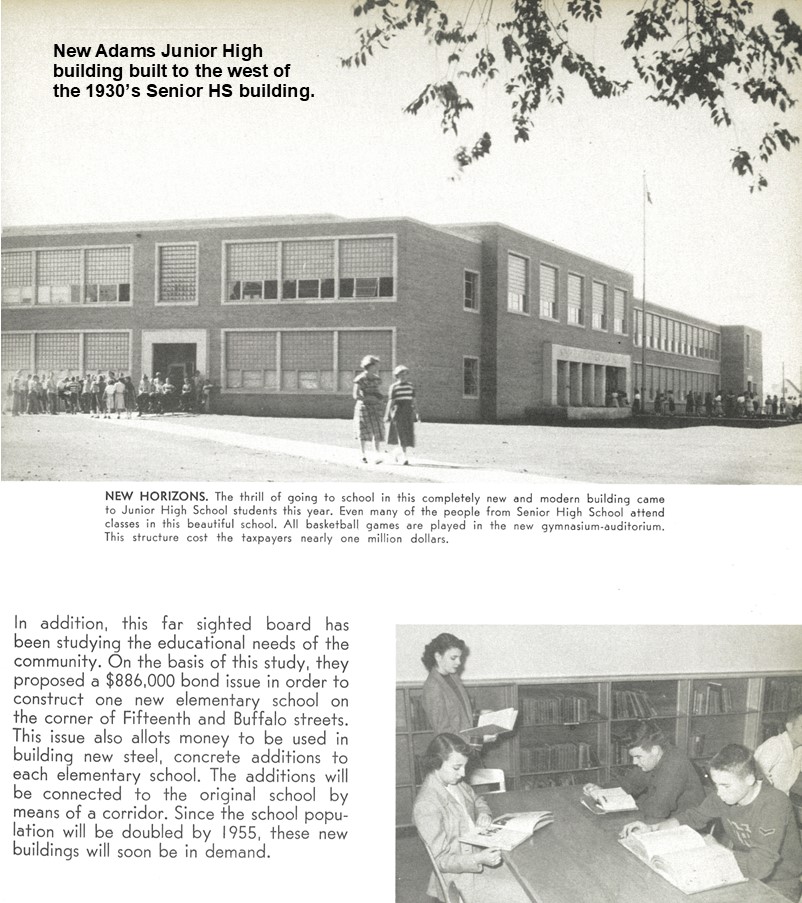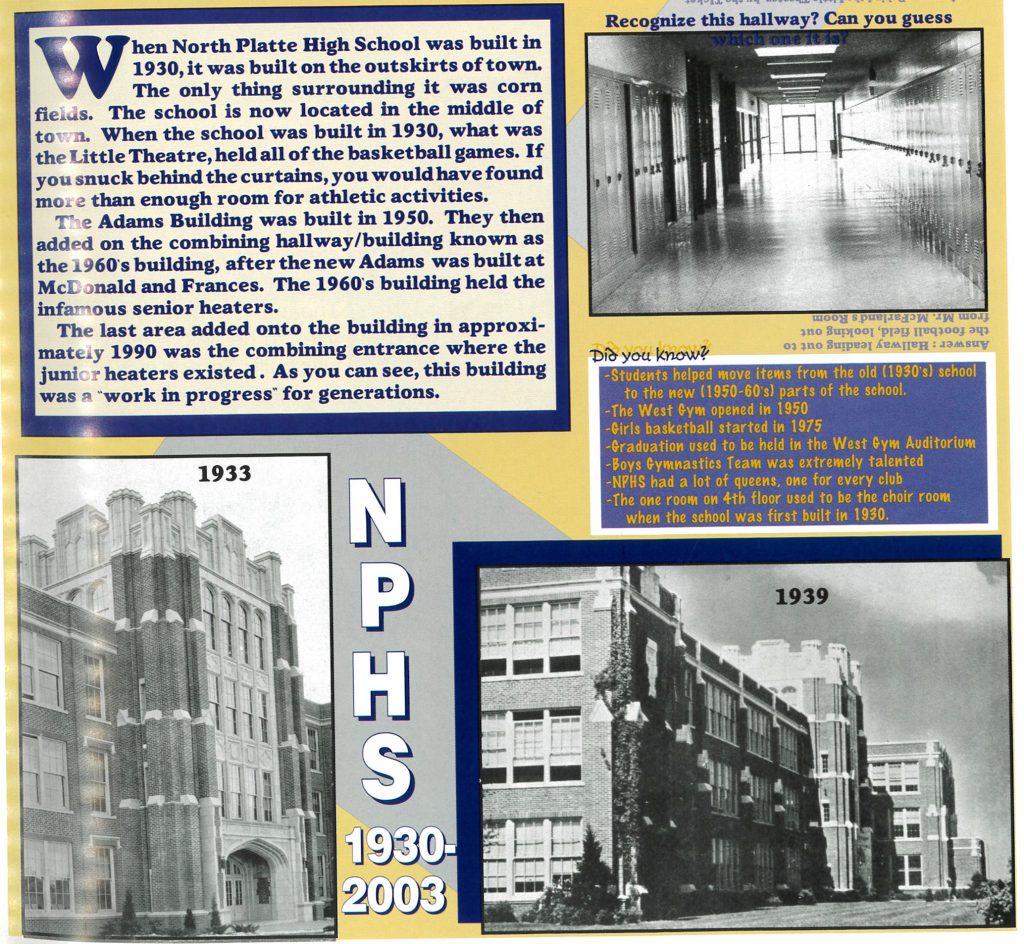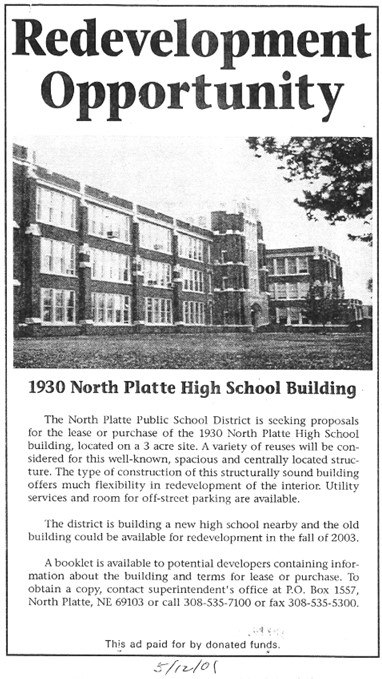Originally published to Facebook.com/NorthPlattePL on March 19, 2021.
Today we continue our salute to North Platte Schools and Education History-with a look at the North Platte High School building, the fourth high school facility built in approximately 1930 and demolished in 2003. This is the high school that many of our readers will remember. Read on for the “short history by year”, and read on for more detailed information:
- 1929 bond issue passes for the construction of the fourth high school
- 1933 new senior high school building opens
- 1948 bond issue passes for the construction of a separate Adams Junior High School building located on the same lot west of the “1930 NPHS building”
- 1950 Adams Junior High School located west of the “1930 NPHS building” opens
- 1963 The 1930 NPHS building addition was constructed
- 1971 bond issue fails
- 1975 bond issue passes for the construction of a new Adams Junior High School building on McDonald Road, plus a connection added between the 1930 original HS building and 1963 addition to the 1950 Junior High building.
- 1993 bond issue fails
- 1997 bond issue fails (this attempt was to build a new high school on East Philip Ave)
- 1998 North Platte High School Facilities Task Force is formed
- 2000 bond issue passes for a new NPHS to be built on the same area
- 2002 North Platte Public Library attempts to save the original NPHS 1930’s building for reuse as a public library.
- 2002 1930’s NPHS building torn down for construction of the new facility.
- 2003 the FIFTH and CURRENT North Platte Senior High School building opens
A special Thank you to the North Platte Telegraph, “The Round-UP” High School Annuals, and the archives of the North Platte Public Library.
Read on for the full story…
By 1920, North Platte’s student population had grown to 1,685 students and the existing High School was overcrowded. For years the overcrowding was so bad that students were in schoolrooms located in the basement of the “old school building” (located where Wells Fargo sits today). The basement rooms were poorly lighted, poorly heated and poorly ventilated.
On the May 28, 1929, the Board of Education asked the people of the school district to authorize the issuance of a $480,000.00 school bond for the purpose of finishing the incomplete Cleveland and Roosevelt schools, and the construction of the Senior High, Cody and Taft schools. The actual cost of JUST the Senior High School building was $364,535.37. The bond issue passed. The new high school was planned on the “outskirts of town,” West 2nd Street.
The tract set aside for the new senior high school was 15 acres, located at 1000 West Second Street. At the rear of the building was the athletic field, which allowed football, baseball, track, and tennis to be played. In addition, a reinforced concrete stadium that seated 1,500 people was built.
The building was of red faced brick and artistically trimmed with terra cotta. All floors were reinforced concrete; the class room floors were covered with “battleship linoleum”. This flooring product was used in high traffic areas and originally manufactured to meet the specifications for the U.S. Navy for warship deck coverings instead of wood, hence the name. The corridors and stairs were made of terrazzo. Terrazzo consisted of chips of marble, quartz, granite, glass or other suitable material, poured with a cement-like binder, or polymeric binder, or a combination of both. The corridor wainscoting was made of glazed brick and there were 700 recessed lockers for the students to use. And finally, a large trophy case greeted students and visitors in the foyer area.
There were 18 classrooms and special laboratory-recitation rooms for physics, chemistry, biology, sewing, cooking, and typewriting. Other special rooms included: music room, manual training shop, auto shop, mechanical drawing room, cafeteria, library, lady teacher room, men teacher rom, administration room, health room, a large study hall and an auditorium.
The auditorium, eventually known as the “Little Theater” seated up to 1,100 people and was equipped with a projection room and a large stage, which also served as a gymnasium. It also had an orchestra pit, a balcony, and side dressing rooms. The large stage gymnasium, with its glazed brick walls, included locker and shower rooms for boys and separate shower facilities for girls. The final performance in the Little Theater was the 2003 Miss Nebraska Scholarship Pageant.
The building was fireproof, beautiful, spacious, convenient, modern, practical, and a monument of pride.
Meginnis and Schaumberg from Lincoln, Nebraska were the primary architects.
Pressured by overcrowded conditions at the existing junior high school, caused freshmen to attend the senior high school, and concerned citizens and parents held another bond issue on April 6, 1948. This bond issue called for the construction of a new junior high school building on the same site as the senior high school building, another 13 acres located adjacent to the 1930 building. The new separate Adams Junior High school was completed in 1950 at a cost of $987,000. In 1963, an addition on the west end of the senior high school was built as part of a two-million dollar bond issue. The addition opened in 1963/64 school year and contained new rooms for science, vocal music, art, as well as new gymnasiums for physical education, wrestling, and gymnastics. The addition also included a new auto mechanics shop, a wood shop, a new library and cafeteria with seating for 300 students.
In the 1970s, a need was recognized to expand, replace, and modernize many of the city’s schools. A 168 page report was complete by the University of Northern Colorado’s Educational Planning Service about the conditions throughout the school district. The report noted that with the high school and junior high school sitting on the same site, it was severely congested. The report also found that many of the North Platte Senior High Schools’ classrooms were too small and that the building itself was overcrowded. In 1975, the Citizens Advisory Committee distributed “Look and See,” a small brochure which highlighted safety and efficacy concerns at a number of school buildings and urged voters to support an upcoming bond issue to address these issues. The $9.99 million bond was approved by 60% on October 21, 1975. Part of the measure called for the construction of a new junior high school on another site (known known as Adams Middle School—located on 1200 McDonald Road) and a connection of the 1930 and 1963 sections of the North Platte High School with Adams Junior High, creating a larger senior high school.
This arrangement remained until January 1998, when another citizens group, the North Platte High School Facilities Task Force, was formed in order to identify and prioritize the North Plate High School Districts’ High School facility’s needs, “to find a solution to those needs, and to recommend the solution to the Board of Education. This task force completed its work in April 1999. The task force identified a number of immediate needs concerning the building’s site, security, education space, mechanical systems, life safety, and accessibility. The group considered both the renovation of the existing building, as well as a new construction project and found that “the total costs of the solutions involving renovation were substantially similar to the cost of construction a new building on the same site.” The groups report noted that the total cost of ownership would be lower for new construction and that the renovation did not resolve all the concerns it had found. As a result, the group recommended the construction of a new facility on the same site.
Despite previous elections for new construction, which failed in 1971, 1993, and 1997, and a proposal for a major renovation of the current building which failed in 1994, a bond issue for the task force’s proposal was passed by 63% on April 4, 2000.The new building was completed in the fall of 2003 at an approximate cost of $29 million dollars.
Even though this bond issue passed and community members broke ground on the new building on April 7, 2001, there was a group of citizens who desperately wanted to save the historic original 1930’s building. This group partnered with library director Cecelia Lawrence to try to save the building for reuse as the North Platte Public Library. On May 14, 2002, a bond issue to save the building and reuse it as a public library, failed with 46% of the voters and the 1930’s building was torn down to make way for a parking lot in the fall of 2002.
This post is Part 2 of a three-part series on the history of North Platte Education and School History. Part 1 (posted on 2/19/21) featured the first three school buildings in North Platte and the challenges facing educators in Western Nebraska. Today’s post is Part 2 and it featured the fourth and fifth High School buildings. Part 3 (scheduled for April 2021) will feature the Catholic School history of McDade and St Patrick’s Schools.



